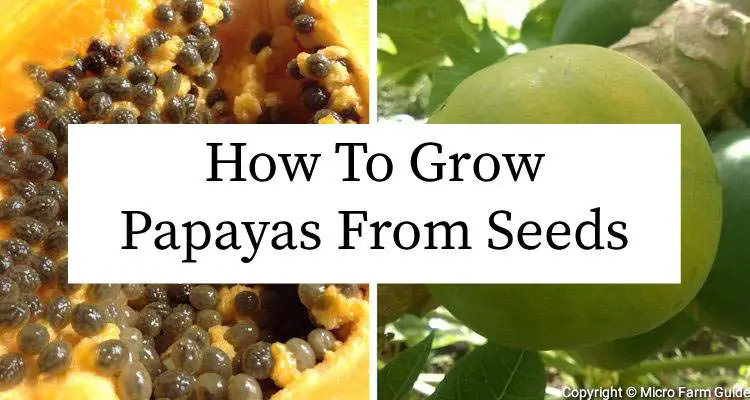Did you know that papayas can grow from seed to harvest in less than one year?
This is fantastic news, especially if you live in the tropics and want to grow papayas in your backyard.
However, for best results, you’ll need to get some things right from the start.
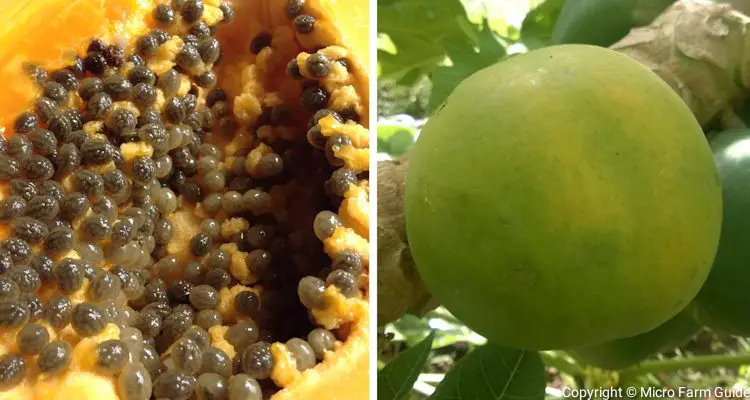
So, in this guide, we’ll walk you through the exact method we use on our farm, from selecting seeds to harvesting your first sweet fruits.
Are you ready? Let’s get started!
1. Select A Suitable Location
Papaya, or Paw Paw, as we call it here on the island, is a sun-loving plant that thrives in direct sunlight. They and tend to grow tall and can topple over if they compete for light.
As a result, you’ll need to choose a location that receives at least 6 hours of sunlight per day.
Also, the soil should be well-drained and loose enough for the roots to grow freely to anchor the plant.
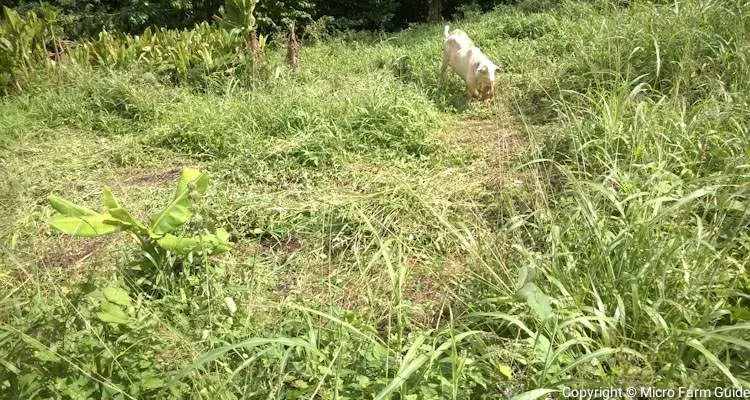
2. Choose The Right Type Of Papaya
Papayas, Carica Papaya, come in various shapes, colors, flavors, and textures, some of which are better suited to specific climates and growing conditions.
For instance, if you live in a warm climate, select one of the larger Mexican varieties or a hybrid suited to your region.
It would be best to contact your local extension office or nursery for information on suitable varieties and to obtain the seeds of the exact type of Papaya you’d like to grow.
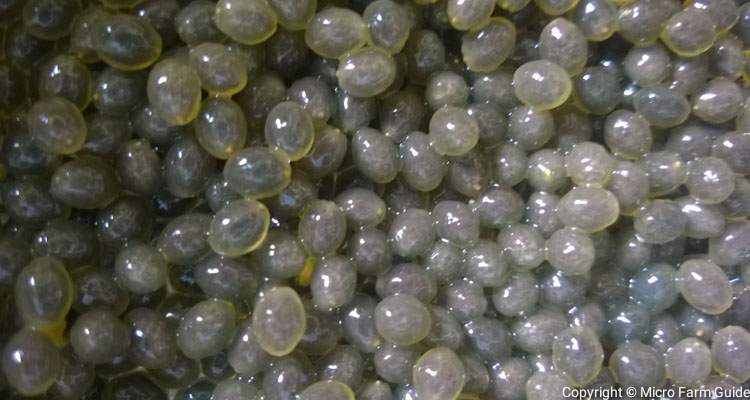
However, you can also use the seeds from the last tasty fruit you ate, preferably one that was grown in your area.
Remember that you might be in for a bit of a surprise since papayas are not always “true to seed” due to cross-pollination.
3. Prepare The Soil
Papayas are not too picky about the type of soil they grow in. However, they prefer fertile, well-drained, slightly acidic to neutral soils.
Add organic matter like compost to improve drainage if your soil is too heavy. This also helps to balance the soil’s acidity naturally over time.
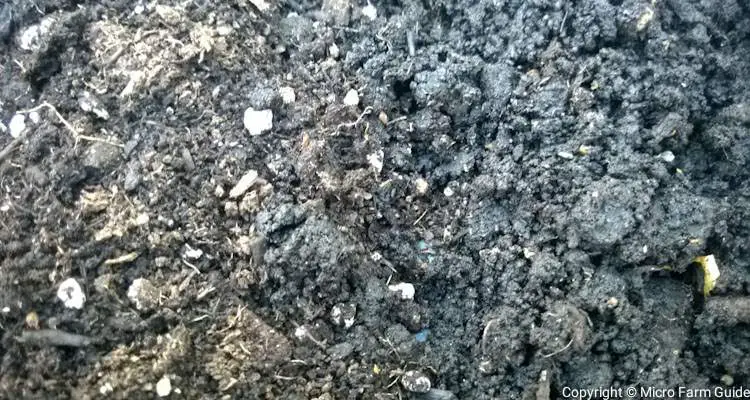
I usually mulch the soil, then add compost in a trench alongside the plants. If space is limited, you can create a Papaya Circle, placing organic material in a pit at the center.
We aim to ensure the soil is loose and crumbly, which helps papaya roots spread quickly and guarantee access to nutrients.
4. Collect And Prepare The Seeds
You can purchase papaya seeds from your local extension office or online from a reputable seed company.
If you choose to collect seeds from a ripened fruit, you will need to cut the fruit, scoop the seeds out, and place them in a container.
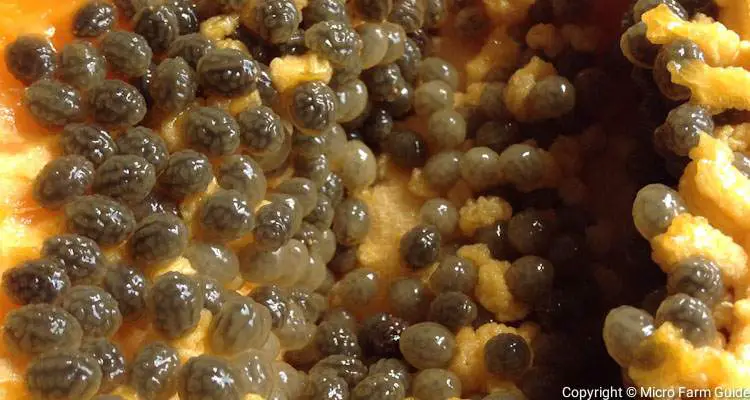
You will then need to separate the mature seeds from the pulp.
I usually fill a container with water and allow the pulp and immature seeds to float to the surface.
Then I remove the floating debris and excess water, leaving mainly clean seeds behind.
You can sow these seeds directly into the ground. However, mix your seeds with some ashes if you wish to store them.
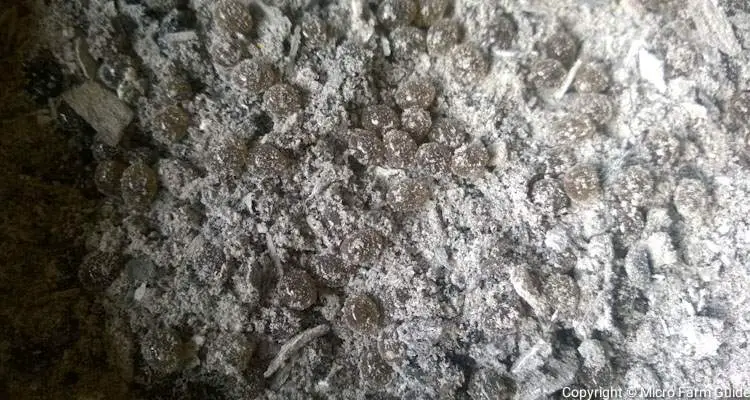
The ash will remove the protective layer, safely dehydrate the seeds, and protect it from ants and fungus while in storage.
5. Plant Papaya Seeds
With your soil and seeds ready, it’s time to plant your papaya seeds.
Some gardeners like to spread the seeds over an entire area by hand or using seed balls, while others sow directly into a hole.
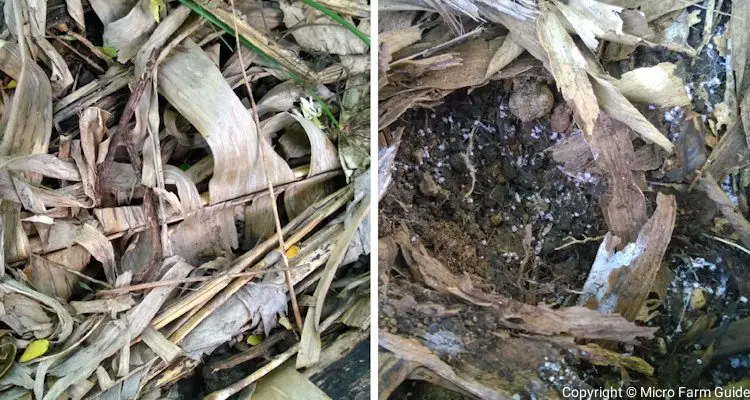
But, for the sake of simplicity, let’s focus on individual holes for now.
- First, make a shallow “nest” in the mulch, leaving a wide enough area to sow your seeds.
- Sprinkle 5 to 10 seeds in the “nest,” then cover with a thin layer of compost, no more than ½ inch deep.
Papayas need space to grow. So, ensure you leave at least 9 feet between holes to allow room for their broad leaves.
Papaya seeds can take up to 3 weeks to germinate. Yet still, the seeds will sprout much faster if they were stored in ashes or pre-soaked in warm water before planting.
6. Care For Your Papaya Plants
Papaya plants are easy to grow, provided you pay attention to their water, sunlight, and nutrient needs.
For instance, Papayas love moisture but don’t like sitting in waterlogged soil. In fact, soggy soil can result in disease or the toppling of plants due to lack of support.
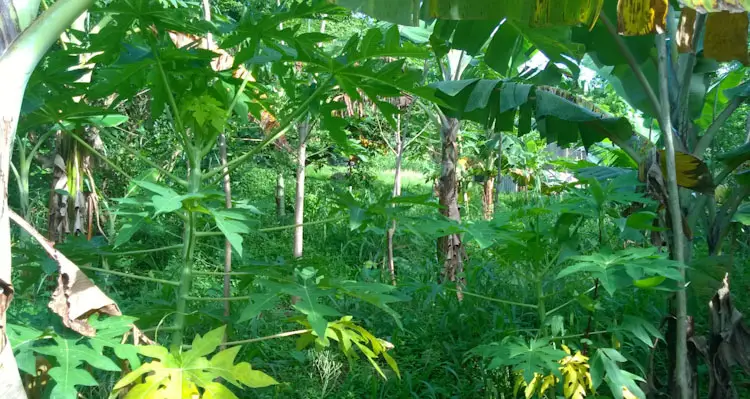
You can use a drip irrigation system to water your Papaya plants.
However, I usually use a thick layer of mulch, which helps to balance the soil’s moisture.
Ensure that your plants receive at least six hours of direct sunlight daily. Remember, papaya trees tend to grow very tall if they have to compete for light.
You can apply organic or natural fertilizers every 2 to 3 months to provide the plants with enough nutrients.
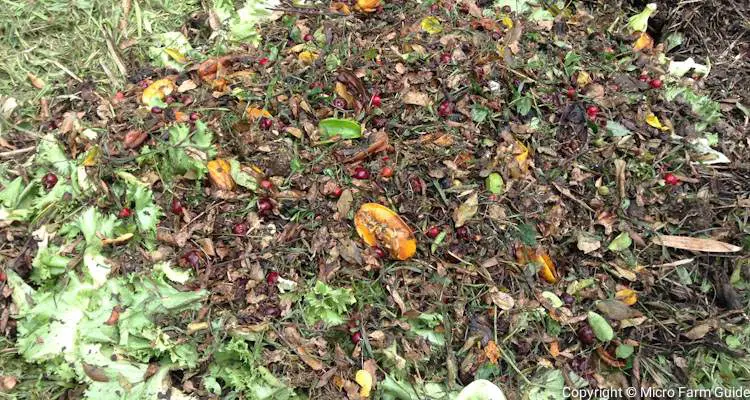
Also, it would help if you considered growing next to a compost pit or trench. If you have depleted soil,
If multiple plants sprout in the same hole, you must thin your young papaya trees. Remove the weaker seedlings, leaving at least 3 vigorous plants per hole.
Monitor the plants as they mature for signs of flowers, indicating the sex of the tree.
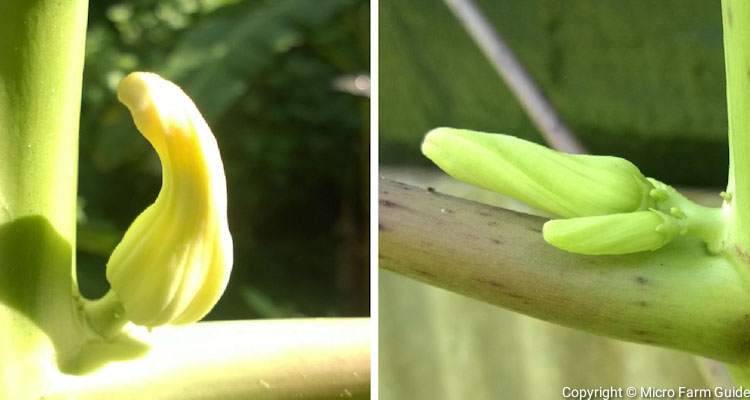
Remember, there are three types of Papaya plants: Male, Female, and Hermaphrodite. The Hermaphrodites are the most sought-after since they are self-pollinating.
Finally, remove the male plants and leave one hermaphrodite or female plant per hole.
Don’t worry about additional pruning since this is only required for Papaya if you intend to create a multi-stem plant.
7. Pest and Disease Management
Papayas are not usually affected by too many pests. However, they are in the same family as okra, cotton, and hibiscus.
As a result, you have to be on the lookout for common pests such as aphids, mealybugs, fruit flies, and other sucking insects.
Learn to recognize signs of pest infestations, such as yellowing leaves or damaged fruit.
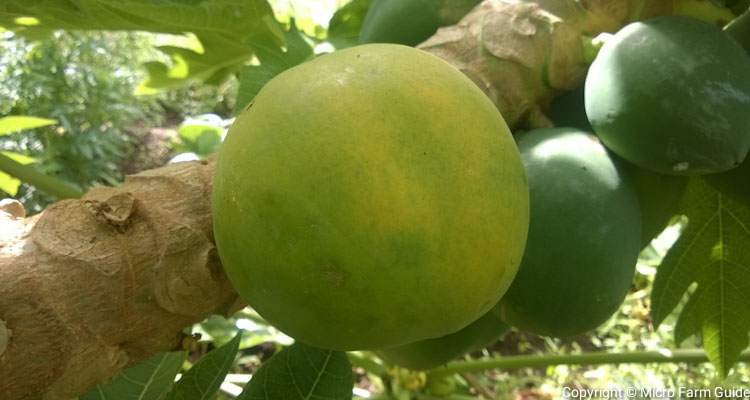
Usually, you can control pests by spraying them off with a stream of water or setting suitable traps.
But, please avoid harsh chemicals since they can harm beneficial insects, such as pollinators.
Instead, use natural remedies like neem oil or companion planting to deter pests.
8. Harvest Papayas
After a few months, you will see some green papayas on the plant.
As papayas ripen, they change color from green to yellow or orange, depending on the variety.
You can harvest papaya green to cook it or process it for other purposes. However, for ripe fruit, you must wait until it is almost entirely yellow/orange before picking.
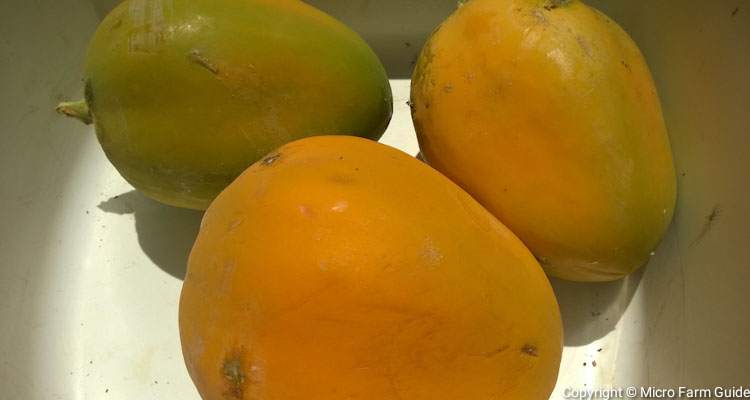
Use a sharp knife or pruning shears to cut the Papaya from the tree. Leave a short stem attached to the fruit.
Be gentle to avoid damaging the plant or fruit. Place the fruit in a cool, dry place at room temperature until fully ripe.
Troubleshooting Common Issues
Sooner or later, you will encounter some issues but don’t panic. Let’s take a look at some of the common ones.
1. Fruit Drop
Papaya may occasionally drop fruit due to poor pollination or extreme stress due to sudden changes in watering or temperature.
There isn’t much you can do except to attract more pollinators or ensure the plants receive constant moisture and nutrients.
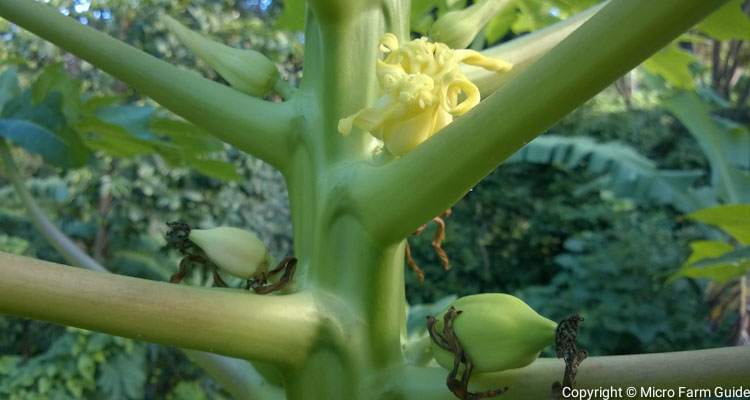
2. Yellowing Leaves
Yellow leaves on your papaya plant may indicate nutrient deficiencies, overwatering, or something worse, such as a virus.
Usually, you will already have an idea of how much water and nutrients your plants are receiving. So you can adjust it accordingly.
Still, pay close attention if you notice other signs of damage, such as the blackening of roots or yellow spots on leaves. These can be signs of more serious fungal or viral diseases.
Final thoughts
Are you ready to roll up your sleeves and grow your papayas?
Remember it’s as simple as choosing the suitable variety, preparing your soil, and nurturing your plants while monitoring signs of pests.
You no longer have to imagine — you can have those beautiful, fruit-laden papaya plants growing in your backyard.
Visit our Gardening Page for more tips, tricks, and resources to help you cultivate the farm of your dreams.
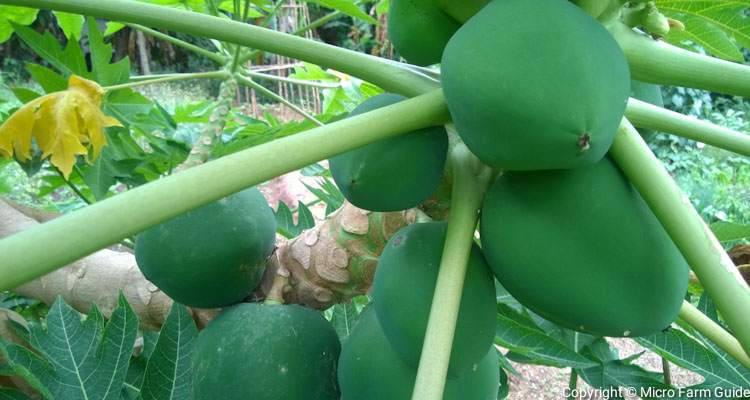
Related Questions
1. How can you tell if a papaya seed is male or female?
Papaya seeds don’t have visible genders. However, some gardeners swear that black seeds are female while brown seeds are male. Still, this has yet to be proven scientifically.
2. Do papaya seeds need to be dry before planting?
You do not need to dry papaya seeds before planting. However, you can dry it using wood ash if you intend to store it for an extended period, safe from mold and ants.
3. How long does Papaya take to grow from seed?
Papayas can take from 6 to 12 months to grow from seed to harvest, depending on the type and growing conditions.
References
IFAS Extension. Papaya Growing In The Florida Home Landscape. edis.ifas.ufl.edu. Accessed October 2023
AgriLife Extension. Papaya. aggie-horticulture.tamu.edu. Accessed October 2023
Ministry Of Agriculture Trinidad & Tobago. Papaya Production – A Producer’s Guide. (PDF) Accessed October 2023

